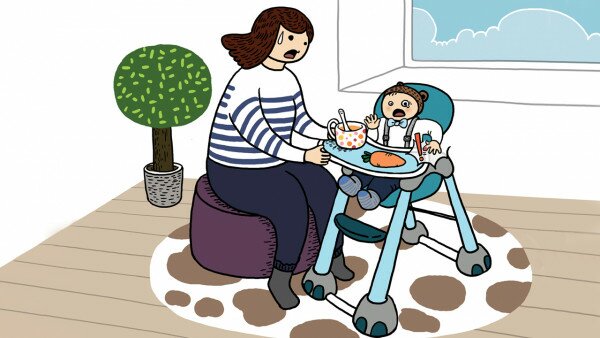It is popular for parents to buy highchairs for their toddlers. High chairs not only make feeding easier, but also help children develop the habit of sitting properly for a meal. The Consumer Council has conducted tests, in collaboration with International Consumer Research and Testing (ICRT), on 13 highchair models. Results showed that 2 models failed to fully comply with the requirements under the European Safety Standard, while the others performed about equally well in all test items, scoring 4 or 4.5 points. The models were priced from $249 to $5,898 but the result showed that the overall performance rating may not be directly related to their price. Consumers are advised to choose a highchair that suits their actual needs.
Highchairs are usually intended to be used by children from 6 months to 36 months of age. Among the tested models, 9 were multifunction highchairs, priced between $1,590 and $5,898. In each of those, the height of the seat or footrest could be adjusted, to fit the growth of the child. These models also adapted to 2 or more modes of usage, such as bouncer or chair. 3 models claimed to be suitable for a newborn baby when converted to the bouncer mode. The remaining 4 models were simple design highchairs that the height of the seat and footrest could not be adjusted. These models were priced between $249 and $2,479, suitable for families on a lower budget.
All models were tested as "dining chairs" mode. Test items included safety, durability, ease of use and versatility, with 5 points being the highest score. The results revealed that apart from the 2 models that obtained only 2 points because of the failures in safety test, the remaining models were rated 4 or 4.5 points.
The European Safety Standard requires that no gaps or holes between 7 and 12mm wide shall be found in the areas of the highchair within the reach of the child. Gaps between the tray and the handle or front bar of the said 2 models did not comply with the standard requirement. This posed a risk of young children getting their fingers caught in these gaps, resulting in injuries. On that basis, both models were rated only 2 points.
Toddlers may move their bodies vigorously while seated in the highchair or push the tray forward with force. These products need to have reliable stability to avoid chairs toppling over. Front, side and rear stability tests were conducted on each model by assessors, and all models passed the tests. As for durability, all models were found to meet the standard requirements, no damage, displacement nor malfunction of safety locks were found after the tests. As a result, all were given full score.
An assessment panel consisting of 3 parents and expert assessors evaluated the ease of use on all models. All models obtained fairly good scores between 4 and 5 points. The panel considered it easy to place a child in or take him/her out the highchairs. 4 models secured the child in the highchair by the tray or by a safety bar, so that parents were not required to unfasten the harness when putting the child into the highchair or taking him/her out. 1 model was found difficult in removing the tray, making that model less convenient.
Children can be messy while eating. Highchairs are prone to becoming stained, when food or drinks spill. Parents ought to clean highchairs regularly to maintain good hygiene. There was no padding on the seats of 8 of the models, which made them relatively easier to clean. A model with a seat cover was found to allow crumbs to become easily trapped in the seams. The seat cover needed to be removed before the crumbs could be cleared.
The space occupied by a highchair is a factor needed to be considered when making a purchase. When in use, the widths of the tested models were between 45 and 60cm, with depths between 54 and 90cm. 5 models could be folded up for easier storage. These are especially suitable for families with relatively small space in their home. Another 5 models had castors, making it easier to move the chairs.
In terms of versatility, height of the seat of 5 models could not be adjusted, but 1 had an adjustable footrest to adapt to the growth of the child. Among the 8 models that allowed adjustment of seat heights, 3 could be adjusted with greater flexibility. The backrest of 5 models could be adjusted to different angles, such as up to reclination or nearly horizontal position.
Parents should pay attention to the following when using a child's highchair:
- Never leave your child unattended in the highchair;
- Never allow your child to climb onto the highchair alone or stand in the seat of the highchair;
- Use the harness if it comes with the highchair. If the child can be secured in the highchair by the tray or safety bar, before use, check to ensure the tray or safety bar is securely locked and make sure the highchair stands are securely locked in place, to avoid folding of the chair causing injury to the child;
- Make sure the highchair is far away from walls, tables and other furniture so kids can't accidentally tip the chair over by pushing hard against other objects;
- Do not move the highchair with the child in it, to avoid tipping it over;
- Inspect the highchair regularly. If it becomes damaged or unstable, stop using it immediately.
The Consumer Council reserves all its right (including copyright) in respect of CHOICE magazine and Online CHOICE.




